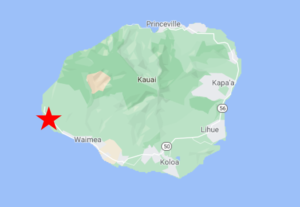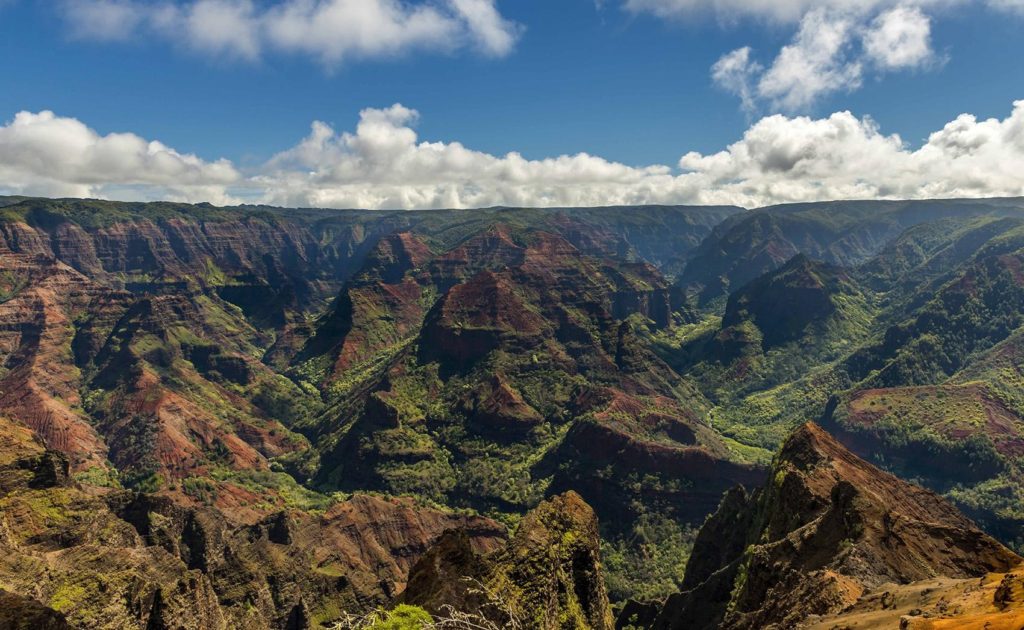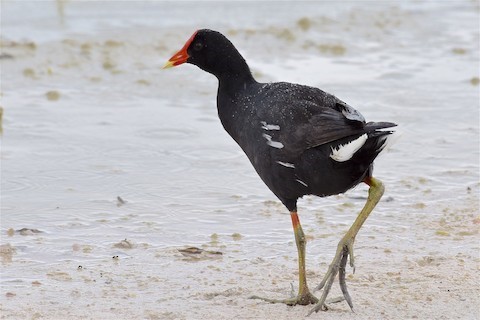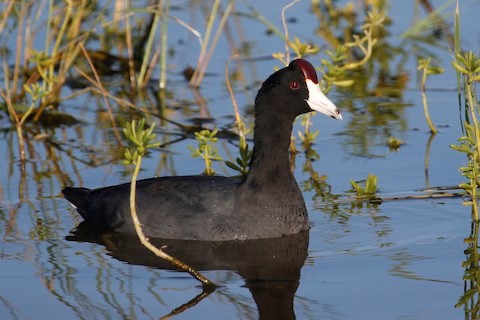Kawai’ele State Waterbird Sanctuary, Kauai, Hawaii

The wetland restoration project at Kawai’ele is a good place to see Hawaii’s endemic waterbirds: especially “Hawaiian Gallinule”, Hawaiian Coot, and “Hawaiian Stilt”, and often Hawaiian Goose and Hawaiian Duck. As a habitat oasis beside the ocean, it regularly attracts migratory waterfowl and shorebirds, sometimes including rarities from Asia. The surrounding fields and brushland support many introduced species, including Black Francolin, and the coastal access at Kekaha can be productive for seabirds.
Orientation
Directions
Kawai’ele State Waterbird Sanctuary is on the southern side of the Kaumualii Highway (a.k.a. Route 50), forty minutes’ drive (33 miles) from Lihue, ten minutes (7.7 miles) past the town of Waimea.
Kekaha Beach Park is also on the southern side of the Kaumualii Highway, 3.7 miles before Kawai’ele, or about midway between the sanctuary and Waimea.
Polihale State Park is about twenty minutes’ drive (8.5 miles) past Kawai’ele. Continue on Route 50 for 1.8 miles, where it forks. Take the right fork (Kao Road, which becomes Kiko Road) for 0.5 miles, then turn left onto Lower Saki Mana Road, which is unpaved. Polihale is approximately six miles down the road, at its end-point.
(Note that the condition of Lower Saki Mana Road varies. Some parts of it may flood in wet weather and others have sand traps. It is not always drivable in a passenger car and some rental agencies may exclude it from the scope of their agreements.)
Attractions
Waimea Canyon, nicknamed “Grand Canyon of the Pacific,” is a short drive east of the Kawai’ele area, and can also be reached more directly from Kekaha via Koke’e Road.

Waimea Canyon, view from Highway 550 en route to Koke’e State Park. © Go Hawaii
Waimea Canyon is the gateway to Koke’e State Park, the montane forest site where Kauai’s endemic birds can be found.
Birdfinding
In its original state, the Mana Plain was predominantly wetlands, but its marshes have been largely drained and converted to other purposes. Largest of all is the U.S. Navy’s Barking Sands Pacific Missile Range Facility, which occupies the westernmost part of the island and prevents public access to a prodigious tract of prime real estate. Nestled along the missile range’s interior boundary is the 35-acre Kawai’ele State Waterbird Sanctuary, a small but productive set of managed ponds, and the core of a restoration project that is planned to cover four times that area: 135 acres.
At the southern and northern ends of Barking Sands are publicly accessible beaches: Kekaha Beach Park and Polihale State Park, respectively. Although the military property would surely have much more to offer if it were open, Kekaha Beach Park is noted as a reasonable vantage point for seabirds. Polihale State Park is more remote and scenic, but generally less productive for birds.

“Hawaiian Stilt” at Kawai’ele State Waterbird Sanctuary. © Joe Nirschl

Kawai’ele State Waterbird Sanctuary. There is a small parking area with a view of the eastern end of the ponds. Some additional access to the site is via a little-used road which runs along the northern perimeter between the ponds and adjacent fields, then ends after about half a mile at a flow control station.
The site supports resident populations of “Hawaiian Gallinule”, Hawaiian Coot, “Hawaiian Stilt”, and Black-crowned Night-Heron, and often hosts a few Hawaiian Goose and Hawaiian Duck. Large flocks of Western Cattle Egret can usually be found in the area.
A few migratory waterfowl are often present, mainly between October and March. Species recorded from the site include: Snow and Cackling Geese, American and Eurasian Wigeon, Northern Shoveler, Northern Pintail, Blue-winged and Green-winged Teal, Ring-necked Duck, Lesser Scaup, and Bufflehead.

“Hawaiian Gallinule” at Kawai’ele Waterbird Sanctuary. © George Gibbs
Migratory shorebirds that occur regularly are Pacific Golden-Plover, Ruddy Turnstone, Sanderling, and Wandering Tattler. Irregular visitors include Bristle-thighed Curlew, Sharp-tailed, Least, and Pectoral Sandpipers, and Long-billed Dowitcher. Rarities have included Bar-tailed Godwit, Ruff, and Slaty-backed Gull. (Perhaps the most remarkable record from the site was a flyby White-tailed Eagle photographed there on April 19, 2007.)
Black Francolin can sometimes be found along the perimeter road—especially in the morning and late afternoon from late February through June when they are most territorial. Other gallinaceous birds reported occasionally include Gray and Erckel’s Francolins, Common Pheasant, and Red Junglefowl. Also reported at least once, and possibly overlooked in this area, is Japanese Quail—introduced to Kauai in the 1930s and is rarely reported anywhere on the island, though sporadic records suggest that it has persisted into the 2020s.

Hawaiian Coot is common at Kawai’ele Waterbird Sanctuary. © Donna Pomeroy
Other landbirds to watch for include “Hawaiian Short-eared Owl”, Japanese Bush-Warbler, Warbling White-eye, Chinese Hwamei, and five species of waxbill: African Silverbill, Scaly-breasted and Chestnut Munias, and less often Red Avadavat and Java Sparrow.
Kekaha Beach Park. Among many spots on Kauai where pelagic birds can often be seen from shore (mainly with strong optics), the beach at Kekaha can be productive mainly late afternoons between February and June. Regular species include: Sooty Tern, Yellow-billed Tropicbird, Laysan and Black-footed Albatrosses, Hawaiian Petrel, Wedge-tailed and Newell’s Shearwaters, Great Frigatebird, and Brown and Red-footed Boobies.
Species that are likely regular offshore, but rarely reported from the park, include: Red-tailed Tropicbird, Bulwer’s Petrel, Sooty and Christmas Shearwaters, Pomarine Jaeger, Brown and Black Noddies, and Gray-backed Tern.
Rare shorebirds have included Bar-tailed Godwit, Sharp-tailed Sandpiper, and Gray tailed Tattler.

Newell’s Shearwater can sometimes be seen from Kekaha Beach Park. © Jacob Drucker
Polihale State Park. More of a scenic beach than a birdwatching destination, Polihale State Park attracts many visitors. Yellow-billed Tropicbird and Brown Booby can often be seen at the beach, and Black Francolin is common in the fields adjacent to the park.
Services
Accommodations
The only large hotel near Kawai’ele and Kekaha is the West Inn Kauai at 9690 Kaumualii Highway in Waimea, 1-808-338-1107. The nearest cluster of hotels is around Poipu.
There is a campground at Polihale State Park: $30/campsite/night for non-residents, $20 for residents. Advance reservations are required.
Notes
Links